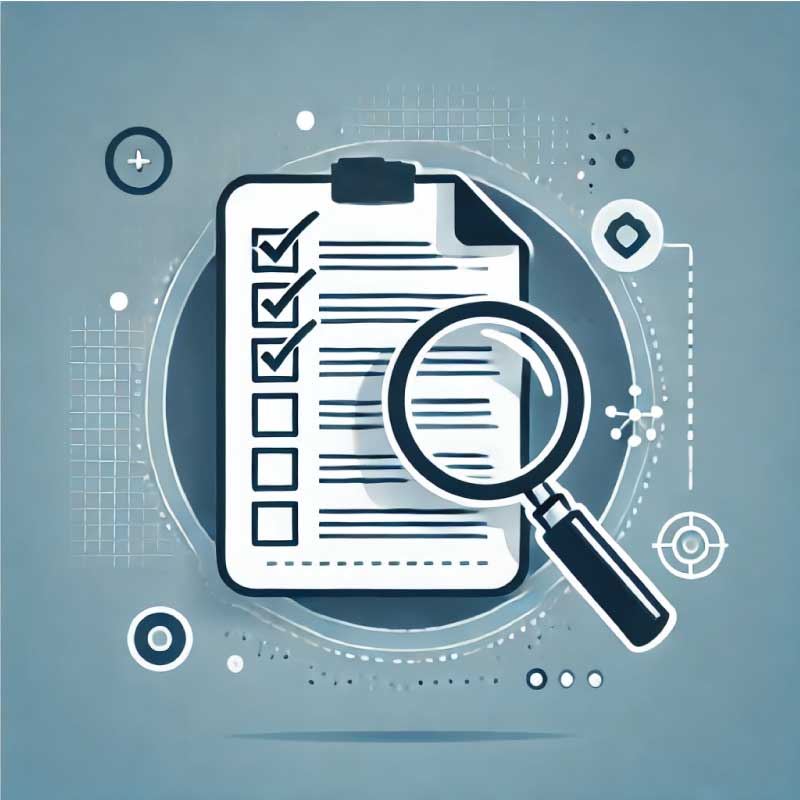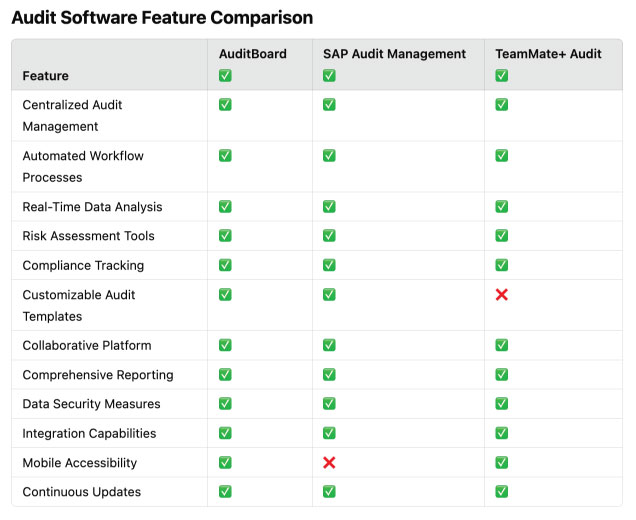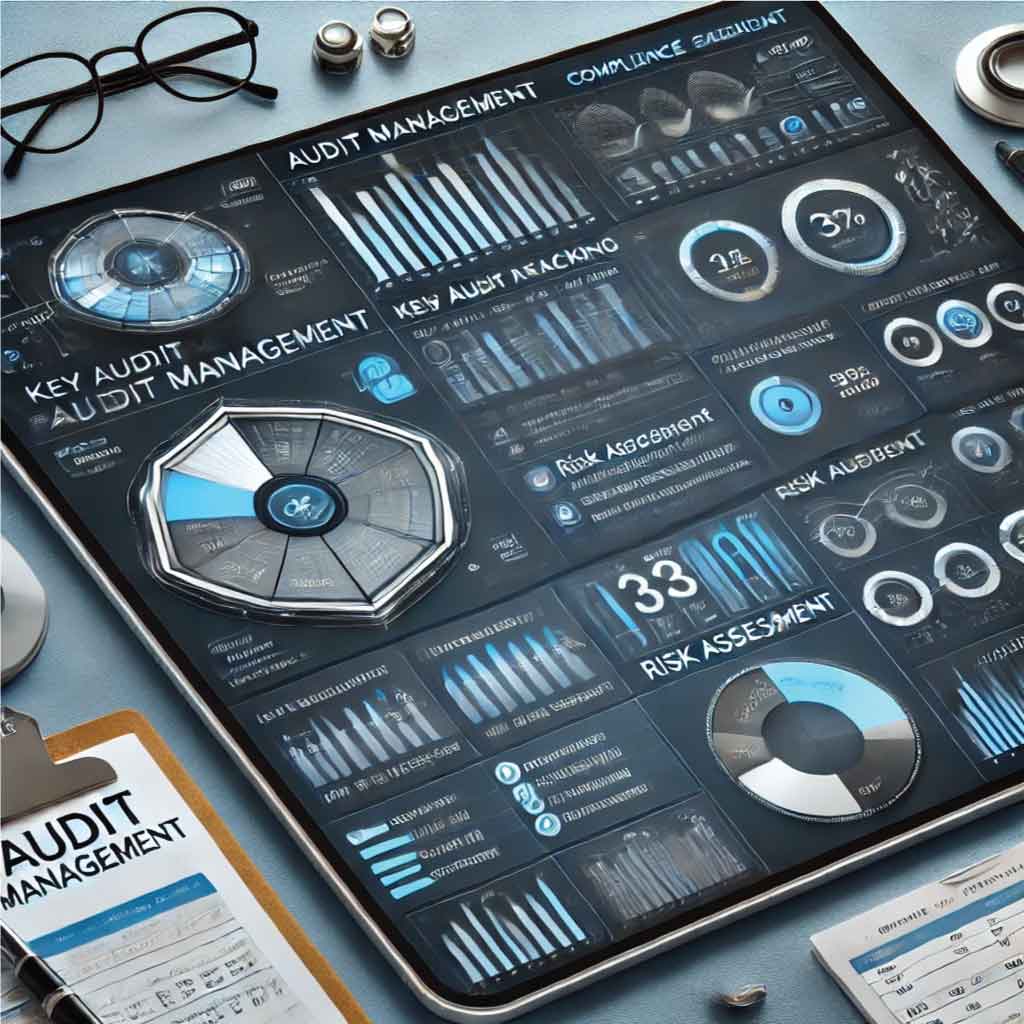Audit software is designed to facilitate the planning, execution, and reporting of audits by automating processes and providing tools for efficient management. Historically, audits were conducted manually, involving extensive paperwork and time-consuming procedures. The advent of audit software has transformed this landscape, enabling auditors to perform comprehensive analyses with greater accuracy and speed.
Notable examples of audit software include AuditBoard, SAP Audit Management, and TeamMate+ Audit.
Related software categories encompass compliance management systems, risk management tools, and governance, risk, and compliance (GRC) platforms, all of which aim to enhance organizational oversight and regulatory adherence.

AuditBoard – A cloud-based audit management solution designed for enterprise risk assessment and compliance monitoring. It features workflow automation and integration with ERP systems.
SAP Audit Management – An advanced auditing platform from SAP that offers deep integration with SAP’s financial and governance tools, ideal for large corporations.
TeamMate+ Audit – A powerful tool focused on internal audit management, risk tracking, and compliance monitoring, used by businesses worldwide.
Resolver – An audit and risk management software that helps organizations analyze compliance risks and automate workflows.
Wolters Kluwer TeamMate Analytics – Provides AI-driven auditing insights, helping auditors perform data analytics with ease.
Workiva – A cloud-based compliance and risk management tool that simplifies the audit process with collaborative features.
CaseWare IDEA – A data analysis tool that helps auditors identify discrepancies, trends, and fraud risks using automation and analytics.
Gensuite Audit Management – A highly customizable audit management solution designed to support various regulatory compliance needs.
Netwrix Auditor – A security-focused audit tool that provides visibility into user activity and access controls across IT environments.
Intelex Audit Management – A compliance-focused audit management system that streamlines the tracking of regulatory requirements.
The following table provides a comparison of key features across three prominent audit software solutions: AuditBoard, SAP Audit Management, and TeamMate+ Audit. This comparison aims to assist organizations in selecting the software that best aligns with their specific audit needs.

The feature comparison table shows that AuditBoard, SAP Audit Management, and TeamMate+ Audit all excel in core audit functions, including centralized management, automation, risk assessment, compliance tracking, security, and integration capabilities. However, TeamMate+ Audit lacks customizable audit templates, and SAP Audit Management does not support mobile accessibility, making AuditBoard the most well-rounded option. SAP Audit Management remains strong for enterprises using SAP systems, while TeamMate+ Audit is a solid choice for organizations that don’t require extensive customization.
If you’re looking to understand how audit software can streamline compliance, risk management, and internal audits, this AuditBoard Product Overview video is an excellent educational resource. AuditBoard is one of the leading audit management platforms, designed to help organizations automate workflows, enhance collaboration, and ensure regulatory compliance. This video provides a clear overview of its key features, demonstrating how the software simplifies audit processes and improves efficiency. Whether you’re new to audit software or exploring solutions for your organization, this overview will give you valuable insights into how modern audit technology can transform your audit strategy.
This audit software dashboard provides a centralized interface for managing audit processes, tracking compliance, and assessing risk within an organization. It displays key audit metrics, real-time risk assessment charts, and an interactive checklist for ongoing audits, ensuring a structured and efficient approach to auditing. Designed with a modern and intuitive layout, the dashboard enables auditors to streamline workflows, identify compliance gaps, and generate insightful reports. With clear visualizations and easy navigation, this tool helps organizations maintain regulatory adherence and improve audit efficiency.

Modern audit software offers a suite of features designed to streamline the auditing process, enhance accuracy, and ensure compliance with regulatory standards. These features collectively contribute to more efficient audit cycles, improved risk management, and better resource allocation.
Centralized Audit Management: By consolidating all audit-related activities into a single platform, organizations can streamline operations, reduce redundancy, and maintain a clear overview of ongoing and completed audits. This centralization facilitates easier access to information and enhances coordination among audit teams.
Automated Workflow Processes: Automation of routine audit tasks minimizes manual intervention, thereby reducing the likelihood of errors and freeing up auditors to focus on more critical analysis. Features such as automated notifications, task assignments, and progress tracking contribute to a more efficient audit process.
Real-Time Data Analysis: The capability to analyze data in real-time allows auditors to identify issues promptly and make informed decisions swiftly. This immediacy enhances the responsiveness of the audit function and supports proactive risk management.
Risk Assessment Tools: Integrated risk assessment features enable auditors to systematically identify, evaluate, and prioritize risks. This structured approach ensures that high-risk areas receive appropriate attention during the audit process.
Compliance Tracking: Continuous monitoring of compliance with relevant laws, regulations, and internal policies is facilitated through compliance tracking features. This ensures that any deviations are promptly identified and addressed, maintaining the organization’s adherence to required standards.
Customizable Audit Templates: Adaptable templates allow auditors to tailor audit programs to specific requirements, promoting consistency and thoroughness across different audit engagements. This customization ensures that the audit approach aligns with the unique aspects of each audit area.
Collaborative Platform: Features that support collaboration, such as shared access to audit documents, communication tools, and collaborative review functions, enhance teamwork among audit staff. This collaborative environment fosters knowledge sharing and improves the overall quality of the audit.
Comprehensive Reporting: The ability to generate detailed reports with various visualization options aids in effectively communicating audit findings to stakeholders. Clear and concise reporting ensures that insights are accessible and actionable.
Data Security Measures: Robust security protocols, including encryption, access controls, and regular backups, protect sensitive audit information from unauthorized access and data breaches. This security is crucial for maintaining the integrity and confidentiality of audit data.
Integration Capabilities: Seamless integration with other business systems, such as enterprise resource planning (ERP) and compliance management systems, allows for a unified approach to organizational oversight. This integration ensures that audit activities are aligned with broader business processes.
Mobile Accessibility: Mobile-friendly features enable auditors to conduct audits in various locations, enhancing flexibility and efficiency. This accessibility ensures that audit activities are not confined to a single setting and can be performed wherever necessary.
Continuous Updates: Automatic updates ensure that the software remains aligned with the latest auditing standards and regulatory requirements. This continuous improvement helps organizations stay compliant and adopt best practices in their audit processes.
Audit software is a digital tool that automates and streamlines audit processes, including risk assessment, compliance tracking, and reporting.
By automating compliance tracking and providing real-time data analysis, audit software ensures organizations adhere to industry regulations and policies.
Yes, most audit solutions integrate with ERP, financial management, and compliance tools for seamless data sharing.
Industries such as finance, healthcare, manufacturing, and government agencies use audit software for regulatory compliance and risk management.
Cloud-based audit software offers flexibility, remote access, and automatic updates, whereas on-premise solutions provide greater control over data security.
Yes, there are scalable audit solutions designed specifically for small businesses to help them manage compliance efficiently.
Essential security features include encryption, role-based access control, audit trails, and compliance with cybersecurity standards.
Real-time data analysis allows auditors to detect risks, monitor trends, and make informed decisions without delays.
Many modern audit software solutions include mobile apps, enabling auditors to conduct field audits and update records remotely.
Customizable templates standardize auditing procedures while allowing flexibility to adapt to different industries and regulatory requirements.